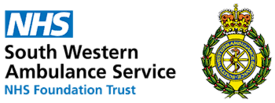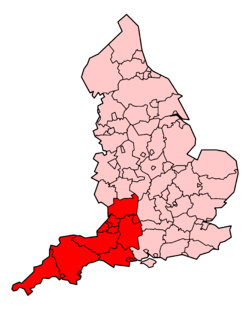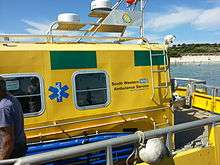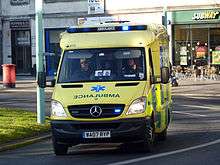South Western Ambulance Service
| South Western Ambulance Service NHS Foundation Trust | |
|---|---|
| SWASFT | |
 The NHS corporate identity logo of South Western Ambulance Service Foundation Trust | |
 Regions served by South Western Ambulance Service | |
| Created |
1 July 2006 (Cornwall, Devon, Dorset and Somerset) 1 February 2013 (merged with Great Western Ambulance Service) |
| Made foundation | 1 March 2011 |
| Headquarters | Abbey Court, Eagle Way, Exeter, Devon, EX2 7HY |
| Region served | Counties and Unitary Authorities of Bristol, Bath and North East Somerset, Cornwall, Devon, Dorset, Gloucestershire, North Somerset, the Isles of Scilly, Somerset, South Gloucestershire and Wiltshire |
| NHS region | NHS England |
| Area size | 51,871 km2 (20,028 mi2) |
| Population | 5.47 million+ |
| Type | NHS foundation trust |
| Establishments | 96 Ambulance Stations |
| Budget | £240.5 million (2016–17)[1] |
| Chair | Tony Fox |
| Chief Exec | Ken Wenman |
| Number of employees | 4,500+ |
| Website |
www |
The South Western Ambulance Service NHS Foundation Trust (SWASFT) is the organisation responsible for providing ambulance services for the National Health Service (NHS) across South West England (the counties and unitary authorities of Bristol, Bath and North East Somerset, Cornwall, Devon, Dorset, Gloucestershire, North Somerset, the Isles of Scilly, Somerset, South Gloucestershire and Wiltshire).[2] On March 1, 2011 SWASFT was the first ambulance service in the country to become a Foundation Trust. The Trust acquired neighbouring Great Western Ambulance Service on 1 February 2013.[3]
SWASFT serves a population of more than 5.47 million, and its area is estimated to receive an influx of over 17.5 million visitors each year. The operational area is predominantly rural but also has large urban centres including Bristol, Plymouth, Exeter, Truro, Bath, Swindon, Gloucester, Bournemouth and Poole.[4]
The headquarters for the service is in Exeter, Devon, and the service has 96 ambulance stations and 6 air bases. The Chief Executive is Ken Wenman, who was appointed on 1 July 2006 on creation of the trust, having previously served as the Chief Executive of the former Dorset Ambulance Service NHS Trust.[5]
The Trust’s core operations include:[6][4]
- Emergency ambulance 999 services (A&E)
- Urgent Care Services (UCS) – GP out-of-hours medical care (Dorset)
- NHS 111 call-handling and triage services (Cornwall, the Isles of Scilly and Dorset)
- Tiverton Urgent Care Centre.

It is one of ten Ambulance Trusts providing England with emergency medical services and employs more than 4,500 mainly clinical and operational staff (including Paramedics, Emergency Care Practitioners, Advanced Technicians, Emergency Care Assistants, Ambulance Care Assistants and Nurse Practitioners). In addition there are around 3,200 volunteers including community first responders, BASICS doctors, fire co-responders and patient transport drivers.
Facts and figures
The Trust is one of the largest in England. It covers an area of 51,871 km and 827 miles (1,331 km) of coastline.[7]
In 2015/16 approximately one in eight 999 calls to South Western Ambulance Service were treated over the telephone. "Hear and treat", where the patient receives clinical advice over the telephone, accounted for 12.7% of calls. For 36.4% of incidents the patients experienced "see and treat", when the patient receives treatment or advice at the scene of the incident. In a further 7.7% of incidents, the patient was taken to a non-emergency hospital department such as a community hospital or minor injuries unit. The remaining incidents resulted in a patient being taken to a hospital emergency department, thus the majority of incidents (56.8%) resulted in a patient not being conveyed.[8]
SWASFT is the best performing ambulance service in the country for non-conveyance rates. In addition approximately 62% of patients taken to hospital are admitted – this is again the highest (best) performance for an ambulance trust in the country. This means that when SWASFT takes a patient to an emergency department they are likely to be admitted, not simply treated and discharged, therefore confirming that is the right place for them to receive the care they need.[9]
There are 96 ambulance stations, six air ambulance bases, three clinical control rooms (999 control rooms), two Hazardous Area Response Team (HART) bases and one boat across the South Western Ambulance Service operational area.[10]
In 2016 the Care Quality Commission told the South Western Ambulance Service to make significant improvements in the NHS 111 service.[11] The inspection of the trust in 2016 identified several areas which required improvement.[12]
In 2018 the trust said it would need an extra £12 million a year to meet the new ambulance performance standards.[13]
Patient feedback
The number of compliments received by the Trust in 2014/15 increased by 41% to 2,055 while complaints also rose by 20% to 1,268.[14]
Divisions and stations
The Trust is split into three divisions:
- West Division: covering Devon and Cornwall, including its Headquarters at Exeter
- East Division: covering (most of) Somerset and Dorset
- North Division: consisting of the footprint of the former Great Western Ambulance Service as well as the Burnham-on-sea and Shepton Mallet stations
The Trust has 96 ambulance stations among the counties that it serves:
- Cornwall
- Devon
- Dorset
- Somerset
- Avon
- Avonmouth
- Bristol
- Keynsham
- Soundwell
- Yate
- North Bristol Operations Centre
- Almondsbury
- Falfield
- Nailsea
- Weston-super-Mare
- Churchill
- Wiltshire
- Gloucestershire
Vehicle fleet

- 306 - 999 Emergency Ambulances
- 57 Patient Transport Ambulances
- 234 Rapid Response Vehicles
- 7 Rapid Response Motorcycles
- 5 Bicycles
- 2 Hazardous Area Response Teams (based in Exeter and Bristol)
- 1 Boat – ALN 043 'Star of Life’ Wave Saver 1000 Class Ambulance Boat
111 service
SWASFT provides the non-emergency 111 helpline and triage service for Cornwall, the Isles of Scilly and Dorset.
Tiverton Minor Injuries Unit
In May 2014 the Trust won a contract to run a doctor-led minor injuries unit at Tiverton and District Hospital, open seven days a week. Patients do not need an appointment to visit the centre, which provides treatment for minor injuries and ailments including:[15]
- Cuts, grazes and wounds;
- Sprains, strains, muscle or joint injury;
- Broken bones (fractures);
- A bite, sting or skin rash;
- Treatment for a minor infection;
- Minor head injuries;
- Eye problems including infections, scratches or foreign objects
See also
References
- ↑ "South Western Ambulance Service – Annual Report and Accounts" (PDF). South Western Ambulance Service. Retrieved 30 July 2017.
- ↑ "What we do". South Western Ambulance Service. Retrieved 6 July 2014.
- ↑ "Single trust formed after South West ambulance merger". BBC. Retrieved 30 December 2017.
- 1 2 "About Us". South Western Ambulance Trust. Retrieved 30 December 2017.
- ↑ "Chief Executive - Ken Wenman". South Western Ambulance Service. Retrieved 30 July 2017.
- ↑ "South Western Ambulance Service NHS Foundation Trust". NHS Choices. Retrieved 30 December 2017.
- ↑ "Inspection Report" (PDF). Care Quality Commission. Retrieved 24 November 2011.
- ↑ "Evaluating the effectiveness of having GPs in the 999 Clinical Hubs (Exeter and Bristol)" (PDF). South Western Ambulance Service. Retrieved 30 December 2017.
- ↑ "South Western Ambulance Service" (PDF). South Western Ambulance Service. Retrieved 30 December 2017.
- ↑ "South Western Ambulance Service". Ambulance Research. Retrieved 30 December 2017.
- ↑ "CQC warns South Western Ambulance Service NHS Foundation Trust about safety of NHS 111 service". Care Quality Commission. Retrieved 30 December 2017.
- ↑ "South Western Ambulance Service NHS Foundation Trust Quality Report 2016" (PDF). Care Quality Commission. Retrieved 30 December 2017.
- ↑ "Ambulance trusts demand millions to meet new targets". Health Service Journal. 4 May 2018. Retrieved 13 August 2018.
- ↑ "SWASFT Annual Report" (PDF).
- ↑ "Tiverton Urgent Care Centre". swast.nhs.uk. Retrieved 11 October 2016.